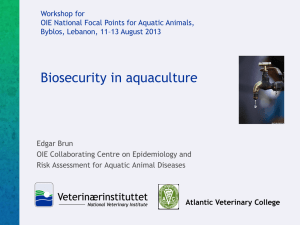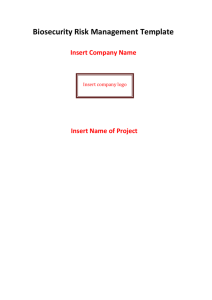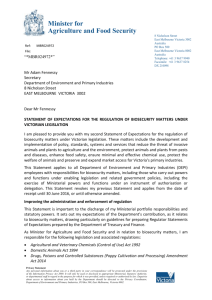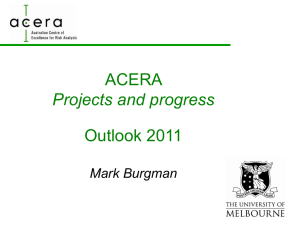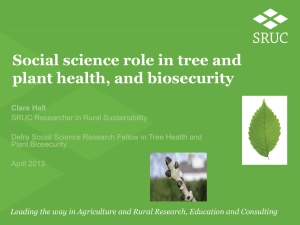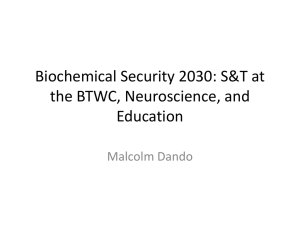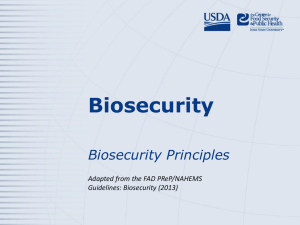Education and Awareness Raising
advertisement
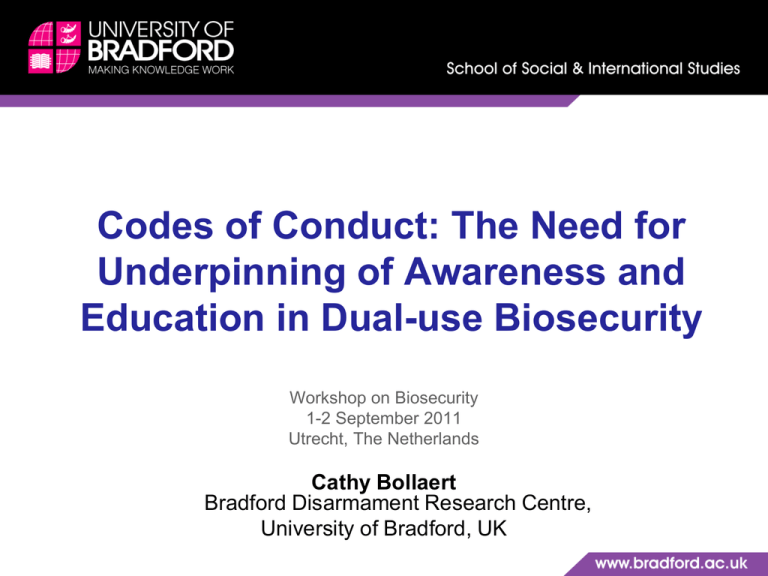
Codes of Conduct: The Need for Underpinning of Awareness and Education in Dual-use Biosecurity Workshop on Biosecurity 1-2 September 2011 Utrecht, The Netherlands Cathy Bollaert Bradford Disarmament Research Centre, University of Bradford, UK Outline 1. Codes of Conduct: Introducing the problem 2. Towards a solution: Online Awareness-Raising and Education 3. Further Developments Biological Threats Spectrum • Natural Disease – Public Health • Accidental Disease – Biosafety • Deliberate Disease – Biosecurity • Laboratory • Wider Education to Strengthen Codes of Conduct Codes of Conduct Important but premature Important but difficult to implement Education informed scientists and policy makers = effective biosecurity policies including CoC Lack of expertise/teachers to provide biosecurity education Train the Trainer Why is there a Problem? B10. University Education in: Europe, Japan, Israel and the Asia-Pacific (AP) Region* Region/ Year Countries Sampled Courses Main Results Europe 2008 142 courses in 29 countries 3 out of the universities in the survey currently offered some form of specific biosecurity module. Japan 2009 197 courses in 62 universities Implementation of ethics education for scientists rarely include dual-use issues. Israel 2009 35 courses in 7 universities Biosecurity act, a report on bioterrorism by its national academy and security council but no education course. AP 2010 197 courses in 58 universities Few biosecurity education courses, and nascent but growing interest for regional cooperation to promote education. Surveys of Biosecurity Awareness • Analysis of interactive seminars conclude that there is little evidence that participants: a. regarded bioterrorism or bioweapons as a substantial threat; b. considered that developments in life sciences research contributed to bio-threats; c. were aware of the current debates and concerns about dual-use research; or d. were familiar with the BTWC • Lack of biosecurity awareness requires explanation: One possible explanation: it does not feature in their university education. University Education Surveys Results of biosecurity education in life science degree courses in Europe: • Only 3 out of 57 Universities offered some form of specific biosecurity module (all optional modules) • Similar results were found in Israel and in the Asia-Pacific Region Solving the Problem: Bottom-up Approaches Education Module Resource – Main Concept • A free (open-source/shareware) on-line educational resource for facilitating the training in Ethics and Dual-Use issues of Life Science Students in Higher Education. – No one size fits all • Content of the resource can be tailored by users for specific academic contexts. http://www.brad.ac.uk/bioethics/EducationalModuleResource/ Education Module Resource • EMR 21 Lectures: Broader Concept of Biosecurity – A. Overview (Lecture1). – B. The Threat of Biological Warfare and Bioterrorism and the International Prohibition Regime (L2-10). – C. The Dual-Use Dilemma and the Responsibilities of Scientists (L11-18). – D. National Implementation of the BTWC (L20). – E. Building a “Web of Prevention” (L21). http://www.brad.ac.uk/bioethics/EducationalModuleResource/ EMR Translations • Implementation: Being tested in Italy, the Netherlands, Poland, Portugal, Spain, Sweden, the UK and Japan. • Language: Available in English, Japanese, Russian, French and Romanian/Moldovan. Will shortly be available in Spanish, Urdu, Polish, Georgian and Arabic… http://www.brad.ac.uk/bioethics/EducationalModuleResource/ Online Train-the-Trainer Courses Course Participants Egypt Disease Surveillance Research Laboratories (DSRL), Global Disease Detection & Response Program Egypt Veterinary Serum and Vaccine Research Institute(VSVRI), Egypt Central Public Health Lab Indonesia Department of Microbiology, Medical Faculty, University of Indonesia Indonesia Morocco Universitè Hassan II Morocco Faculty of Sciences Dhar El Mahraz Morocco National Institute of Hygiene, Ministry of Health Nigeria College of Peace and Social Sciences,Salem University Eijkman Institute for Molecular Biology Pakistan University of Karachi Jordan Princess Haya Biotechnology Center/Jordan University of Science and Technology Pakistan Armed Forces Institute of Pathology, Combined Military Hospital Jordan Jordan University of Science and Technology Pakistan Dept. Plant Sciences, Quaid-i-Azam University, Islamabad Jordan Jordan University of Science and Technology Philippines College of Public Health, UP Manila Jordan Head, Dept. of Biological Sciences, Yarmouk university Philippines Foreign Service Institute Philippines University of the Philippines Manila Kenya Kenya Medical Research Institute/Centers for Disease Control and Prevention Consultant Medical Microbiologist, Hamad medical Corporation Kenya UNIVERSITY OF NAIROBI/ NATIONAL BIOLOGICAL AND TOXIN WEAPONS COMMITEE Qatar Qatar National Commitee for the Prohibition Of Weapons Kenya Centre for Biotechnology Research and Development, Kenya Medical Research Insitute Qatar Qatar University, Department of Health Sciences Kenya International Livestock Research Institute (ILRI) Russia I.I.Mechnikov Research Institute for Vaccines and Sera: UAE Abu Dhabi University Kenya National Council for Science and Technology, Ministry of Higher Education, SCience, and Technology Uganda National Airport Services, Medical Laboratory Morocco University Sultan Moulay Slimane Yemen National Center for Public Health Laboratories Applied Dual-Use Bioethics/Biosecurity: Online Distance Learning Train-theTrainer Course Learning Outcomes: to build capacity of participants to develop: 1. Knowledge & Understanding – Review and appraise ethical/biosecurity themes and methods relevant to dual-use. 2. Discipline Skills – Integrate dual-use biosecurity issues and concerns into their own training programmes. Key Themes of the Course A. The Threat of Biological Warfare (BW) and Biological Terrorism (BT) B. International Prohibition Regime C. The Dual-Use Dilemma D. Responsibilities of Life Scientists E. National Implementation of the BTWC F. Building an Effective Web of Prevention to Ensure Benign Development Law Ethics Science Biosecurity Competence Tools: Elluminate, NING and Blackboard • Elluminate – Live platform for lectures and seminars, – Virtual classroom enabling the interaction amongst participants backed up by (PPTs, Webcam, Audio equipment), • NING Induction and social networking platform outside of lectures • Blackboard Archives of the course: lecture PPTs, videos, hand books Course Structure and Assessment Two types of courses 1x 30 Credit Module (UK Higher Education Master’s level credit): 12 Lectures + 12 Seminars-Real-World Scenarios based discussions 1x Certificated Course: 6 lectures in 6 weeks Assessment: 30 Credit Module 1. Coursework: 50% Reflective applied written individual assignment: 3,500 - 4,000 words. 2. Groupwork Report: 50% Online group-work presentation (25%) and one related written group-work assignment (25%) of 2,000 words Seminar Scenario As members of a research team you find a method of rapid synthesis viruses. Presumably it would also allow you to (re)create potentially dangerous pathogens. In a 2000-word report outline what your further actions would be, taking into account biosecurity, biodefence and ethical considerations. What do Course Participants get? They get: • A qualification - 30 (transferable) Masterlevel Credit from a UK HE institution • Evidence of awareness and education on biosecurity • Membership of a supportive network that seeks to build sustainable capacity in dualuse biosecurity References • • • • • • Rappert, B (ed.)(2010) Education and Ethics in the Life Sciences: Strengthening the Prohibition of Biological Weapons, Canberra: Australian National University E Press, Available from: http://epress.anu.edu.au/education_ethics.html Revill, J., Mancini, G., Minehata, M. and Shinomiya, N. (2009) “Biosecurity Education: Surveys from Europe and Japan,” Background Paper for the International Workshop on Promoting Education on Dual-Use Issues in the Life Sciences, 16-18 November 2009, Warsaw, Poland: Polish Academy of Sciences, Available from: http://dels.nas.edu/bls/warsaw/background.shtml Minehata, M. and Friedman, D. (2009) “Biosecurity Education in Israeli Research Universities: Survey Report,” Research Report for the Wellcome Trust Project on Building a Sustainable Capacity in Dual Use Bioethics, Available from http://www.brad.ac.uk/acad/sbtwc/dube/publications/Israel_BioSecReport_Final.pdf Minehata, M. (2010) An Investigation of Biosecurity Education for Life Scientists in the Asia-Pacific Region. Available from http://www.brad.ac.uk/bioethics/media/SSIS/Bioethics/docs/Asia_Pacific_Biosec_Investigation.pdf National Research Council. (2009) A survey of Attitudes and Actions on Dual Use Research in the Life Sciences: A Collaborative Effort of the National Research Council and the American Association for the Advancement of Science, Washington, D.C.: National Academies Press. Available from: http://www.nap.edu/catalog.php?record_id=12460 United Nations. (2008) Report of the Meeting of States Parties, 11 December, BWC/MSP/2008/5, Available from: http://www.unog.ch/80256EE600585943/(httpPages)/F1CD974A1FDE4794C125731A0037D96D? OpenDocument Acknowledgements Landau Network Centro Volta, Italy. National Defense Medical College, Tokyo, Japan. Bio Engagement Program, Department of State, USA. Thank you! Facebook: http://tinyurl.com/bioseced Twitter: http://twitter.com/#!/DualUseBioSec Skype: dual.use.biosecurity http://www.brad.ac.uk/bioethics/
